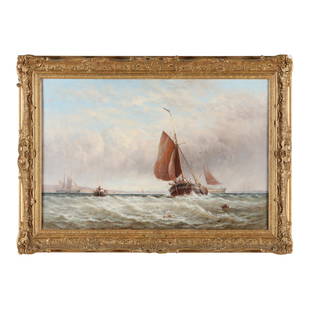
George Lance (British, 1802-1864)
George Lance Sale History
View Price Results for George LanceRelated Paintings
More Items in British Paintings
View MoreRecommended Art
View More




Item Details
Description
George Lance
(British, 1802-1864)
"Now Reigns Here a Very Very Peacock"
oil on canvas
unsigned, with "Owen Edgar Gallery" label en verso.
Framed.
68" x 52", framed 75" x 59"
Provenance: Owen Edgar Gallery, London, England; Private collection, California.
Exhibited: Royal Academy, London 1855, No. 432,
Centennial Exhibition Philadelphia, PA. 1876,
Owen Edgar Gallery, London, "Victorian Master Paintings", May-June 1984.
Notes: In this monumental painting of a regal peacock amidst an extravagant still life, set in what appears to be a palace garden, Lance is simultaneously showcasing his virtuosity with a brush and his keen eye for observation of botany, anatomy, and architecture, inspired by Dutch and Flemish Old Masters.
The paintings of the seventeenth-century artists were rife with symbolism, wherein depictions of flowers, fruits and vegetables acted as messages of morality and religious reminders to avoid gluttony and excess. The peacock has been depicted in art since the ancient times and is seen as a symbol of beauty, rebirth, and wealth, as well as of sinful pride. The birds originally came from India over 4,000 years ago where they were symbols of royalty, and from the 1800s, they began to populate Western visual and decorative culture.
Still life paintings were popular with the rising middle classes, starting in the 17th century and continuing well into the 19th and early 20th centuries. Indeed, George Lance, an artist of modest background and no monetary support from family, decided to specialize in still life paintings as he needed the economic security of a steady market.
Growing up in rural Essex might have also had an influence on his exhaustive study of the chosen subject matter of botany and horticulture. Nineteenth-century England saw much social, cultural, and economic change, and many important scientific discoveries were made during this period. Indeed, all branches of science including botany, zoology, geology, anthropology, chemistry, physics, astronomy, and medicine experienced major developments and expansions. The Royal Society led the effort to promote understanding of science and scientific inquiry which was directly linked to technological innovation. Indeed, Victorians witnessed how these various scientific and technological discoveries brought economic success which enabled Britain to become the most powerful nation during this era.
This economic success resulted in the even greater rise of bourgeois class, members of whom soon became patrons of the art and had purchasing power allowing for works of art to adorn their new lavish homes, such as the work offered here.
(British, 1802-1864)
"Now Reigns Here a Very Very Peacock"
oil on canvas
unsigned, with "Owen Edgar Gallery" label en verso.
Framed.
68" x 52", framed 75" x 59"
Provenance: Owen Edgar Gallery, London, England; Private collection, California.
Exhibited: Royal Academy, London 1855, No. 432,
Centennial Exhibition Philadelphia, PA. 1876,
Owen Edgar Gallery, London, "Victorian Master Paintings", May-June 1984.
Notes: In this monumental painting of a regal peacock amidst an extravagant still life, set in what appears to be a palace garden, Lance is simultaneously showcasing his virtuosity with a brush and his keen eye for observation of botany, anatomy, and architecture, inspired by Dutch and Flemish Old Masters.
The paintings of the seventeenth-century artists were rife with symbolism, wherein depictions of flowers, fruits and vegetables acted as messages of morality and religious reminders to avoid gluttony and excess. The peacock has been depicted in art since the ancient times and is seen as a symbol of beauty, rebirth, and wealth, as well as of sinful pride. The birds originally came from India over 4,000 years ago where they were symbols of royalty, and from the 1800s, they began to populate Western visual and decorative culture.
Still life paintings were popular with the rising middle classes, starting in the 17th century and continuing well into the 19th and early 20th centuries. Indeed, George Lance, an artist of modest background and no monetary support from family, decided to specialize in still life paintings as he needed the economic security of a steady market.
Growing up in rural Essex might have also had an influence on his exhaustive study of the chosen subject matter of botany and horticulture. Nineteenth-century England saw much social, cultural, and economic change, and many important scientific discoveries were made during this period. Indeed, all branches of science including botany, zoology, geology, anthropology, chemistry, physics, astronomy, and medicine experienced major developments and expansions. The Royal Society led the effort to promote understanding of science and scientific inquiry which was directly linked to technological innovation. Indeed, Victorians witnessed how these various scientific and technological discoveries brought economic success which enabled Britain to become the most powerful nation during this era.
This economic success resulted in the even greater rise of bourgeois class, members of whom soon became patrons of the art and had purchasing power allowing for works of art to adorn their new lavish homes, such as the work offered here.
Condition
Professionally conserved, relined with new stretcher bars. Surface abrasions along edges from contact with frame. Signs of inpainting upper right (above and surrounding peacock's head); lower and mid left (leaves and architecture); lower center (background above apples) and lower left (fruit along craquelure pattern); vertical area of inpainting lower right (left of pear). Frame with surface marks, nicks and abrasions.
Buyer's Premium
- 25%
George Lance (British, 1802-1864)
Estimate $10,000 - $15,000
20 bidders are watching this item.
Shipping & Pickup Options
Item located in New Orleans, LA, usSee Policy for Shipping
Local Pickup Available
Payment

TOP

















































































